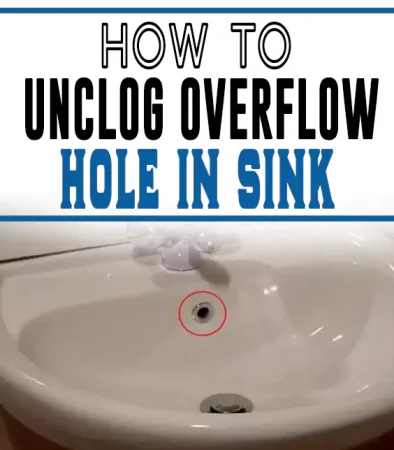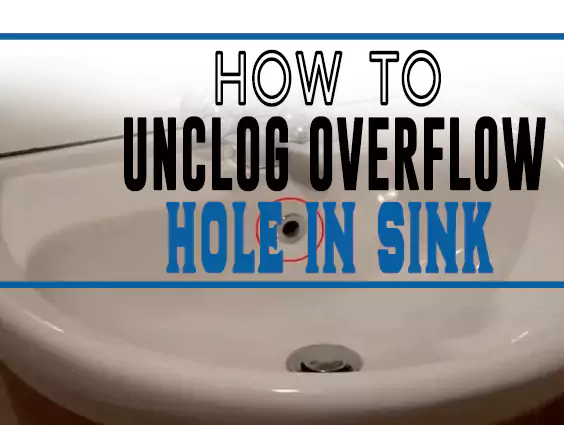The overflow hole in the sink is one of the most overlooked parts, although it plays a crucial role. This is why it’s important to know how to unclog overflow hole in the sink.
Located at the top part of the sink, the overflow opening is primarily tasked with preventing your sink from overflowing.
As the water begins to overflow, the overflow hole diverts it to give you enough time to find a solution. It does so by creating a suction effect with zero air getting into the water, helping it drain slowly.
However, it can easily clog due to sludge or other smaller items accumulating over time. Recognizing that not everyone is a plumbing genius, we’ve shared the best fool proof guide on how you can thoroughly clean and clear your sink’s overflow hole.

Why is the sink overflowing full of water?
Several factors can be the reason why your sink overflow is full of water. The number one factor that leads to a sink overflow being full of water is the lack of frequent cleaning.
Over time, gunk and other debris (such as hairs, toothpaste, creams, and oils) may build up near the bottom of the overflow channel.
If the cleaning of a sink overflow hole and its channel is rarely done, this may restrict the flow of water and air. In turn, you will end up with an overflowing sink.
However, this is not the only reason why a sink overflow can be full of water. Other factors associated with a flooding sink overflow can be accidentally running water for extended periods or serious plumbing problems associated with the entire sink.
Unclogging Overflow Hole in Sink
There are 5 methods you can use to unclog sink overflow drains.
1. Using zip ties
The method of using zip ties is perhaps the most popular option for the unclogging and cleaning of a sink overflow hole. Zip-ties work great when it comes to pulling debris out. They are also quite affordable compared to options such as drain cleaners.
For this method to effectively work, you will need a long plastic zip tie that can extend and bend to cover long distances and difficult-to-access areas. Since they are built to easily bend, long zip-ties can very easily circumvent a sink’s curve.
Nonetheless, they remain tough and hard enough to pull out any debris build up. Moreover, a longer zip tie is much easier to handle.
- Start by inserting the pointed end of a zip tie into the opening of the overflow hole
- Slowly move the zip tie forward then establish a slow back and forth, side and side motion to help d clear out any debris blockage along the away
- Continue with this until you remove all the debris built up
2. Using a rubber hose
If you lack zip-ties, the next thing lying around your home to unclog sink overflow drains is a rubber hose. First, you want to make sure the hose is strong enough. Anything close to a 7/8 inch dishwasher safe hose is fine.
- Open the tap and run the water to fill up the sink to a level slightly higher than the overflow opening. This will automatically prompt some water to run down the overflow opening.
- After a little water has run down the hole, attach one end of the hose to the opening.
- Through the other unattached end of the hose, blow a few puffs of air into the hole.
- Drain the water from the sink and blow more puff of air through the hose again.
- Continue doing so until you can feel air blowing freely through the hole without much resistance.
3. Using a plunger
If a rubber hose doesn’t sound so appealing, you can opt for a plunger. In fact, most plumbers prefer to use a plunger as the first solution before going for other methods if it doesn’t work.
However, using a plunger to unclog the overflow holes in sinks doesn’t necessarily require attaching it to the hole. This is because, during this process, the plunger will fully seal off the drain. Instead, you want to plunge the main drain since the overflow is connected to it.
- Start by filling half the sink with water.
- Submerge the plunger into the water and tilt it to fill its cup.
- Place the plunger on the drain to seal it and begin to plunge as you open the stopper.
- If the overflow passage is clogged, this action will force whatever clogs it to back up, forcing the water and debris/gunk build up. to shoot out of the overflow hole.
4. Using DIY liquid cleaner
There are several variations of liquid cleaning mixtures you can use to unclog sink overflow drains. For example, you can mix one part chlorine bleach or enzyme drain cleaner with one part water. Enzyme drain cleaner is a better option for homes with septic systems to ensure the mixture is safe in the system.
- After mixing the two liquids, use a container with a pour spout to pour it down the overflow hole.
- If your mixture contains chlorine bleach, let it sit for up to 15 minutes. If it contains enzyme drain cleaner, let it sit overnight.
- Once done, simply flush the overflow with plain clean water.
If you don’t have any bleach or drain cleaner, you can use items readily available in your home. These include a cup of distilled white vinegar and baking soda, along with 4 cups of boiling water, and a funnel. This method is ideal for when the overflow drain is clogged and releases an odor.
- Place the funnel into the overflow drain hole and pour baking soda into it.
- Next, gently pour the vinegar. As you pour, you will notice a fizz as vinegar combines with the baking soda.
- Once you are done, let the mixture sit for about 15 minutes.
- Pour boiling water into the funnel to clean it out and leave a pleasant smell.
5. By Disassembling the sink
You will find instances where the methods above simply don’t work. In this case, many people would prefer to call a plumber. However, if you can disassemble your sink without damaging it, you can do so to safely and manually remove it.
- To disassemble the sink, start by disconnecting the pop-up stopper and removing the stopper lever from the tailpiece of the drain.
- Examine these areas as the object is more likely to be dislodged there. If you still can’t find it, use a long zip tie to continue probing in areas that aren’t visible.
- If you still can’t find the object, it’s time to call the plumber!
How to Examine an Overflow Sink Hole?
Typically, the sink features double-walled construction with the main drain pipe and one that runs from the overflow, connecting the two at the bottom to the main waste pipe. There are two ways you can examine an overflow sink hole.
Method 1
If you can do so, manually disassemble the sink near the overflow area. This process follows the same steps as disassembling the sink.
- Start by disconnecting the pop-up stopper (this holds the water by sealing the drain).
- Remove the stopper lever near the drain tailpiece area.
- Once done, physically observe these parts. You can examine the overflow hole sticking a long zip tie further up the path to the overflow opening. If you don’t notice any debris or gunk, the overflow hole should be clean and clear.
Method 2
Alternatively, you can simply examine the overflow sink from the outside. This 2-in-1 process involves the use of a zip tie. While a long zip tie helps unclog the drain as outlined above, you can also use it to examine the hole for any clogs or dirt.
Even if the Ziploc alone will not remove all the dirt build up or stuck items, when you push it down the drain and pull it out, you will see the signs.
There’s a reason why there is a wide range of methods for the cleaning of a sink overflow hole. This is because different methods are suited to cater to varying circumstances. For example, if a hard object (non-disposable) is stuck in the overflow passage, a liquid cleaner or plunger may not do the trick. You are better off using a zip-tie.
On the other hand, gunk build up caused by elements like oils or soap can easily be removed using liquid cleaners.
A plunger does a good job with gunk build up with elements like hairs. In this case, there is always a solution to help you unclog the overflow holes in sinks in your home. The overflow hole rarely clogs. Nonetheless, it’s good practice to clean it from time to time to prevent clogging and unwanted odor.
